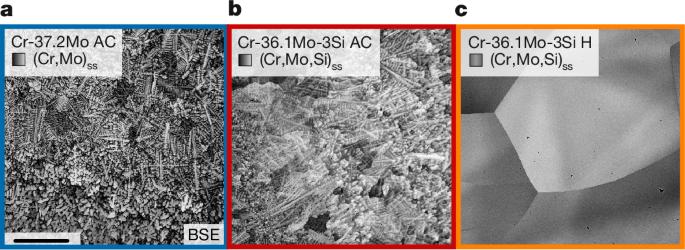A ductile chromium–molybdenum alloy resistant to high-temperature oxidation
IF 48.5
1区 综合性期刊
Q1 MULTIDISCIPLINARY SCIENCES
引用次数: 0
Abstract
Even with the rapid development of renewable energy sources, improving the efficiency of energy conversion from fossil or synthetic fuels remains a challenge because, for example, combustion engines in long-range aircraft will still be needed in the upcoming decades1. Increasing their operating temperatures (1,050–1,150 °C (refs. 2–4)) is one option. This requires replacing single-crystalline Ni-based superalloys in the hottest sections of turbines by refractory-element-based materials, which exhibit much higher solidus temperatures beyond 2,000 °C (refs. 5–7). Here we introduce a single-phase Cr-36.1Mo-3Si (at.%) alloy that meets, for the first time, to our knowledge, the most important critical requirements for refractory-element-based materials: (1) relevant resistance against pesting, nitridation and scale spallation at elevated temperatures, minimum up to 1,100 °C, and (2) sufficient compression ductility at room temperature. Although strength and creep resistance in such alloys were already superior to Ni-based superalloys in several cases, oxidation/corrosion resistance, mandatory to withstand the combustion atmosphere, and ductility/toughness, needed for damage tolerance and device setting, still pose barriers for the development or application of refractory-element-based candidate materials. Any previous successful attempts to address the otherwise catastrophic oxidation of Mo and nitridation of Cr during oxidation suffered from a loss in ductility at ambient temperatures. A single-phase chromium–molybdenum–silicon alloy is described that exhibits compression ductility at room temperature as well as resistance to oxidation, pesting, nitridation and scale spallation at temperatures up to at least 1,100 °C.

耐高温氧化的延展性铬钼合金
即使随着可再生能源的迅速发展,提高从化石燃料或合成燃料转换能源的效率仍然是一个挑战,因为,例如,在未来的几十年里,远程飞机上仍将需要内燃发动机。提高其工作温度(1,050-1,150°C(参考文献2-4))是一种选择。这就需要用耐火材料基材料取代涡轮机最热部分的单晶镍基高温合金,耐火材料基材料的固相温度要高得多,超过2000°C(参考文献5-7)。这里我们引入单相Cr-36.1Mo-3Si (at)。据我们所知,这种合金首次满足了耐火元素基材料最重要的关键要求:(1)在高温下抗害虫、抗氮化和抗剥落,最低温度可达1100°C;(2)在室温下有足够的压缩延展性。尽管在某些情况下,这些合金的强度和抗蠕变性能已经优于镍基高温合金,但抗氧化/耐腐蚀性(必须承受燃烧气氛)和延展性/韧性(损伤容限和设备设置所需)仍然是耐火元素基候选材料开发或应用的障碍。以往任何成功解决氧化过程中Mo的灾难性氧化和Cr的氮化的尝试都受到了环境温度下延展性损失的影响。本文描述了一种单相铬钼硅合金,它在室温下具有压缩延展性,并且在至少1100℃的温度下具有抗氧化、抗虫害、抗氮化和抗剥落的性能。
本文章由计算机程序翻译,如有差异,请以英文原文为准。
求助全文
约1分钟内获得全文
求助全文
来源期刊

Nature
综合性期刊-综合性期刊
CiteScore
90.00
自引率
1.20%
发文量
3652
审稿时长
3 months
期刊介绍:
Nature is a prestigious international journal that publishes peer-reviewed research in various scientific and technological fields. The selection of articles is based on criteria such as originality, importance, interdisciplinary relevance, timeliness, accessibility, elegance, and surprising conclusions. In addition to showcasing significant scientific advances, Nature delivers rapid, authoritative, insightful news, and interpretation of current and upcoming trends impacting science, scientists, and the broader public. The journal serves a dual purpose: firstly, to promptly share noteworthy scientific advances and foster discussions among scientists, and secondly, to ensure the swift dissemination of scientific results globally, emphasizing their significance for knowledge, culture, and daily life.
 求助内容:
求助内容: 应助结果提醒方式:
应助结果提醒方式:


